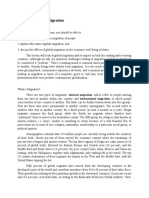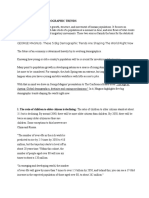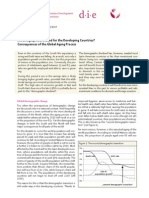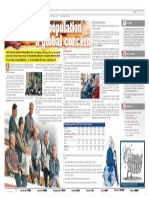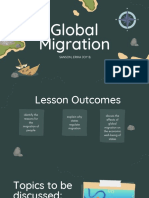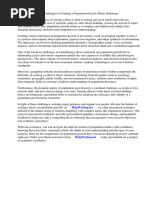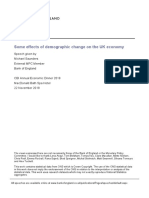Social Security Advisory Board
Social Security Advisory Board
Uploaded by
moncadamCopyright:
Available Formats
Social Security Advisory Board
Social Security Advisory Board
Uploaded by
moncadamCopyright
Available Formats
Share this document
Did you find this document useful?
Is this content inappropriate?
Copyright:
Available Formats
Social Security Advisory Board
Social Security Advisory Board
Uploaded by
moncadamCopyright:
Available Formats
SOCIAL SECURITY ADVISORY BOARD
ISSUE BRIEF #1:
The Impact of Immigration on Social
Security and the National Economy
December 2005
Prepared by Joel Feinleib and David Warner
The challenges facing the Social Security
program and the economy as a whole will grow
over the coming decades as the Baby Boom
generation enters retirement and as improvements
in human longevity contribute to an inevitable and
significant increase in the proportion of Americans
over the age of 65.
Preparing for this future requires those
interested in shaping future public policy to gain a
greater understanding of the long-term changes in
our population and economyincluding trends in
fertility, mortality, productivity, employment and
wage growth. As life spans increase and fertility
rates remain steady at or just below replacement
rate, a large and growing part of those changes will
be shaped by the volume and composition of
immigrants coming to this country and their
descendents. In fact this change has already begun.
The Presidents Council of Economic Advisors
recently reported that from 1996 to 2003, nearly
60 percent of net employment growth, and
50 percent of the growth of the working age
population was due to recent immigrants.
For each session of the Forum, the Advisory
Board posed a set of broad questions that formed
the context under which immigration was
considered and discussed by the participants. The
questions posed for the Projecting Long-Term
Immigration session focused on the following: How
can we best improve our methods for projecting
future immigration and how can we best develop
the assumptions on which our projection models are
based? How do we address key policy issues
despite our uncertainty over long-range
projections? How will immigration affect the size
and composition of our population and the ratio of
workers to retirees? What effect will immigration
have on long-term productivity and employment?
Will it raise or lower wage growth? What effect
On September 7, 2005 the Social Security
Advisory Board convened two panels of
demographers, economists and immigration
experts to examine the long-range impact of
immigration on Social Security and the national
economy. The Forum was divided into two
sessions, one on measurement and projection,
and the other on managing global migration. At
each session, papers were presented to
participants by the assembled experts, followed
by a discussion of each paper among
participants.
The first session, Projecting Long-Term
Immigration, focused on current trends and
projection methods and the importance of
accurate projections for formulating sound
economic and social policy. Presenters in this
session included Dr. Richard Jackson from the
Center for Strategic and International Studies,
and Dr. Jeffrey Passel from the Pew Hispanic
Trust. Discussants for this session included
Dr. Barry Edmonston from Portland State
University and Dr. John Wilmoth from the
United Nations Population Division. The second
session, Managing Global Migration, focused on
managing international migration and policies
to assure an adequate labor supply for the future.
Presenters in this session included Dr. Demetrios
Papademetriou from the Migration Policy
Institute and Dr. Michael Teitelbaum from the
Alfred P. Sloan Foundation. Discussants for this
session included Dr. Wolfgang Lutz from the
International Institute for Applied Systems
Analysis and Dr. Susan Martin from the Institute
for the Study of International Migration.
Board member Martha Keys moderated the
Forum.
will immigration have on the finances of local,
state, and national governments? And how will the
long-term trends affect the long-term financial
situation of the Social Security trust funds, if at all?
The questions posed for the Managing Global
Migration session were focused on the following
themes: Why do people migrate? Which social,
economic, and political forces are most likely to
explain future global patterns of migration? Can
the U.S. effectively manage the amount and
character of immigration to this country? How
important will competition for the most
economically advantageous migrants be? What
role will the aging of developed societies and the
related need to provide retirement security for their
workers play in the global patterns of migration?
What role will demographic and economic change
in the developing world play in migration patterns?
What role, if any, does a stable system of retirement
security play in attracting an adequate workforce?
It was not expected that the discussions at the
Forum would answer all of these questions but the
larger inquiry into the implications of immigration
on the long-term trends in the economy and Social
Security financing were guided by them.
While recognizing the importance of
immigration to our future patterns of economic and
population growth, the Social Security Advisory
Board does not view immigration as a panacea or
free lunch for saving Social Security. The Social
Security Administrations (SSA) Office of the
Chief Actuary estimates that an increase in legal
immigration of about a quarter of a million would
reduce the 75-year actuarial deficit of the Social
Security program by about 5 percent under the
current set of assumptions.
The Impact of Immigration on Population and
National Age Structure
Immigration is an increasingly important
determinant of population growth as the rate of
natural increase declines due to relatively low birth
rates (although U.S. births rates are still
significantly higher than Canada, Europe and
Japan). [see Figure 1] Immigrants also represent
an increasing share of the labor force. The mix of
skills, education and productivity in the economy is
increasingly determined by the skills, education and
productivity among the foreign-born share of the
labor force and their offspring.
Figure 1:
Annual growth in population from natural increase vs.
immigration (10 year averages, in millions)
Natural Increase
Net Migration
3.0
2.5
2.0
1.5
1.0
0.5
1951-60 1961-70 1971-80 1981-90 1991-00 2001-10 2011-20 2021-30
Source: Census Bureau(various years); Wilmoth(2003); R. Jackson (2005)
Current estimates of immigration to the U.S.
by 2050 encompass a huge range. The Census
Bureau estimates of flows into the country in 2050
range from a low of 166,000 per year to 2.8 million
with a middle estimate of 980,000. The Bureau of
the Census estimates of total U.S. population in
2050 range from 353 million under low
immigration assumptions to 498 million under high
immigration assumptions (with a midpoint of
404 million).
The 2005 Economic Report of the President
estimates that over the last 10 years as much as
58 percent of employment growth in the U.S. and
51 percent of growth in the working age population
has been due to new immigrants.
The U.S. (like most of the developed world) is
on a trajectory of significant aging due to the Baby
Boom cohort entering retirement years and steady
increases in the life expectancy at birth and at age
65. Since most immigrants to the U.S. tend to enter
the U.S. as young adults rather than as children,
they do not lower the average age of the population
by very much. As they age along with the nativeborn population, they tend to raise the average age
of the nation. However, they also tend to have
slightly higher fertility rates than non-immigrant
the Social Security Advisory Board does
not view immigration as a panacea or free
lunch for saving Social Security.
This is not a trivial amount but neither is it a
solution to the long-term solvency of the program.
It does remind us that immigration will change both
the structure of the population and the workings of
the economy. This is the context under which the
Advisory Board has pursued its work on
immigration. Below is a summary of what the
Board heard at its September 7th Forum.
families. The age at entry of immigrants and their
fertility rates will have some mitigating effect on
the overall aging of the population, although it is
likely to be very slight.
arrival of unauthorized or illegal immigrants has
exceeded the number of legal arrivals since about
1995. About 30 percent of the 35 million foreign
born persons in the U.S. are unauthorized migrants.
Most illegal immigrants, almost 80 percent, have
arrived since 1990.
Foreign born residents of the U.S. are
predominantly from Mexico (32 percent), the rest
of Latin America (23 percent) and Asia
(25 percent). While the sources of U.S.
immigration have changed dramatically since the
first half of the 20th century, it is not unprecedented
to have as large a share coming from just one
country (as had previously occurred with Irish and
German immigrants). Almost 60 percent of illegal
immigrants are from Mexico with 25 percent from
the rest of Latin America.
The Magnitude of Immigration Effects on Social
Security Finances
Legal immigrants contribute taxes to the Social
Security Trust Funds but are likely to eventually
become beneficiaries of the system as well
(although some may return to their country of
origin before eligibility). Among illegal
immigrants, SSA actuaries currently assume that
about half actually pay social security taxes
although they are very unlikely to collect benefits.
The number of immigrants entering the country
affects the size of the working age population, the
size of the labor force, the number of workers in
OASDI covered employment, and thus the size and
growth rate of GDP. In addition the children of
immigrants will continue to affect the size and
growth rate of GDP and the ratio of workers to
beneficiaries well into the future. A 2004 memo
from the Office of the Chief Actuary pointed out
that the change in the actuarial balance of the Social
Security Trust Fund from an increase in
immigration of about 250,000 per year would be
about 0.1 percent of taxable payroll, or about
5 percent of the currently projected actuarial deficit.
In the 2005 Social Security Trustees Report, the
range of estimates in the long-term actuarial
balance of the Trust Funds between the low
(672,500) and high (1,300,000) immigration
assumptions amounts to a swing of .44 percent of
taxable payroll (from -2.11 to -1.67).
Figure 2:
U.S. foreign-born population and percent of total population:
1850-2005
Foreign-born population (in millions)
Percent of total population
35
30
25
20
15
10
5
0
1850 1860 1870 1880 1890 1900 1910 1920 1930 1940 1950 1960 1970 1980 1990 2000 2005
Source: U.S. Census Bureau; Passel (2005)
Immigrants tend to have high attachment to the
labor force. Many families are of mixed status
with a combination of authorized and unauthorized
members, often with children who are citizens.
Immigrants tend to occupy both extremes of the
skill/education distribution, many with less than
average education and a smaller but significant
percentage with higher than average education
levels.
Dr. Passel projects that future immigration will
play a dominant role in the growth of the U.S. labor
force over the next half century. Successive
cohorts will have higher levels of education (a
smaller percent will have very low levels). And the
aged dependency ratio will be slightly lower than
without any immigration, but not nearly enough to
offset the large increase due to the aging of the
Baby Boom and increase in life spans.
Current Trends in Immigration
Jeffrey Passel described recent trends in
immigration to the U.S. The number of immigrants
coming to the U.S. has been steadily increasing
since the late 1960s and is now at an all-time high,
with about 15 million arriving during the last
decade for a total foreign born population of about
35 million. [see Figure 2] A similar number are
expected to enter the U.S. during the present
decade. The share of the population that is foreign
born is approximately 12 percent, approaching the
all-time high of nearly 15 percent near the start of
the 20th century.
Almost two-thirds of recent legal immigrants
are admitted to the U.S. either because they are
immediate relatives or fall under other family
sponsored preferences. Only about 15 percent are
based on employment preferences. The annual
U.S. Immigration in the Context of Migration
Throughout the World
projections should be based on a definable
methodology rather than on ad-hoc assumptions.
He discussed incorporating into the projections
explanations of what drives immigration based on
social science theory and suggested that approach
could yield better estimates than trend-based
projections. Prevalent social science explanations
for what motivates migration include inter-country
wage differentials, the process of globalization,
intra-family economic planning and the existence
of social networks and institutions which facilitate
and reinforce migration patterns.
Michael Teitelbaum argued that theories about
why people migrate are not as predictive as we
might like. Even massive demographic trends such
as the Baby Boom and the Baby Bust are very
hard to predict over the long term. In addition,
government policies toward migration have perhaps
as important an effect on the size and direction of
migration patterns as do economic, social and
demographic forces. The future direction of public
policy and the political, social or economic
conditions that give rise to them are inherently
unpredictable. To Teitelbaum, the problem is that
the long-term future is largely unknowable and thus
setting policy over the long term will require
choices made in spite of that uncertainty rather than
through some effort to clarify it.
Demetrios Papademetriou warned that data on
just who is and is not a migrant are not consistent
across countries, and this makes it difficult to
estimate with certainty the extent of migration
throughout the globe. For example, individuals are
counted as immigrants in France only until they are
granted citizenship. By contrast, the U.S. keeps
track of all foreign-born residents. In addition, a
large share of persons in the countries comprising
the former Soviet Union, found themselves
reclassified as immigrants merely as a consequence
of the redefinition of national borders following the
dissolution of the USSR.
According to demographer Michael
Teitelbaum, the UN estimates that about 3 percent
of the world population lives outside their country
of birth. While this is a small fraction, it amounts
to roughly 175 million to 200 million persons.
They are unevenly distributed; 9 percent of
developed countries population is foreign-born
compared to only 1.5 percent of developing
countries.
The U.S. has the largest stock of foreign-born
persons but the share of the population (12 percent)
is similar to other large developed countries such as
France (10 percent), Russia (9 percent) and
Germany (9 percent); but not very high compared
to many very small countries.
Figure 3:
U.S. Population projections by immigration assumptions:
Census Bureau: 2000-2100 (in millions)
Projecting Immigration into the Future
Zero Migration Series
Middle Series
Population in millions
It is the obligation of the Social Security
Trustees to project the finances of the Social
Security Trust Funds over the next 75 years. The
assumptions and methods used to make such longrange assumptions are complex and open to debate.
At present the Trustees intermediate assumption is
that immigration to the U.S. will stay constant over
the long term comprised of a level of legal
immigration consistent with current immigration
law with the addition of a constant number of
other immigrants, i.e., non-legal immigrants and
other categories. Since 1999 the Advisory Board
has empanelled at four year intervals a group of
outside experts to review the Trustees assumptions
and review the projection methods of the Social
Security actuaries. The 2003 Technical Panel on
Assumptions and Methods recommended changes
to both the assumptions and methods for projecting
future levels of immigration.
Richard Jackson addressed several significant
issued related to projecting immigration over the
long-term. His main contention was that
Low Migration Series
High Migration Series
850
750
650
550
450
350
250
2000 2010 2020 2025 2030 2035 2040 2045 2050 2060 2070 2080 2090 2100
Source: U.S. Census Bureau (2000)
There was fairly widespread agreement among
the Forum participants that methods that
characterize the full range of possible future
estimates in probabilistic terms are more
informative than presenting high, low and medium
variants of projected outcomes. [see Figure 3]
John Wilmoth discussed the changes to the
Trustees current immigration projections
recommended by the 2003 Technical Panel, of
which he was a member. Offering a critique of
incorporating theories of migration into projection
methodology, Dr. Wilmoth argued that explaining
why people migrate, even if correct, cannot tell you
the size of immigration flows which is the crucial
variable for long-term projections. He further
argued that limiting projections to what the current
immigration law allowed made little sense
especially over the long-term. For example,
although there are numerical limits on legal
immigration, family members of immigrants can, in
many cases, qualify for legal immigration well in
excess of those numeric limits. Not only is the
legal limit hard to predict, but illegal immigration
could fluctuate widely and may currently exceed
flows of legal immigrants.
The 2003 Technical Panel, therefore,
recommended using methods that were based on
simple rules and that were consistent with historic
trends. In accordance with those principles, the
Panel recommended the Trustees adopt a method
that assumes future immigration to the U.S. will
grow proportionately with the overall population
rather than at a constant level. Such a change
would involve a substantial increase in the
intermediate projection of the numbers of future
immigrants.
temporary guest worker program brought about
large scale permanent migration.
According to demographer Wolfgang Lutz,
Europe and North America dominate todays world
because they have a large accumulation of welleducated human capital. But in the future, we can
expect to see rapid increases in human capital
accumulation in Asia, particularly in India and
China, surpassing that of North America and
Europe. India will soon be the worlds most
populous country. Moreover, there has been a huge
momentum in that country in recent years toward
improvements in education. China will have more
people of working age by 2015 with secondary and
tertiary education than Europe and North America
together. This is because China has invested a
great deal in education in recent years.
Dr. Lutz also explained that the inevitable
aging of the population in developed countries will
increase the demand for workers to provide
services. Many of these workers will have to be
imported from other countries. However, the need
for workers is expected to be so great that it may
also begin to threaten the cultural identity of
some nations especially in Europe. In addition,
increased immigration might also raise the concerns
of domestic workers about unemployment and
foreign competition for jobs.
According to immigration expert Susan Martin,
the feminization of migration is another important
issue that needs to be on the public policy agenda,
most certainly when dealing with policy areas that
are affected by the composition of the population.
Women have always migrated, but they are doing
so increasingly in recent years. In addition, women
are now immigrating more frequently as primary
wage earners, not just as spouses or daughters
following a male migrant. In some countries, for
example Indonesia, women comprise about
70 percent of emigrants.
The reasons that women are migrating are
equally important. Women tend to migrate into
service jobs, like nursing, that support the elderly
and children. But nursing is only a sliver of the
demand for labor in support of the elderly that is
likely to increase as a result of the aging of the
population.
Dr. Martin also believes that the transportation
revolution has had an extremely important impact
on immigration because it is now less expensive to
migrate. The communications revolution the
growth of cell phones, Internet, etc. has broken
down some of the psychological barriers to
migration. It is now easier to travel long distances
and easier to communicate with family left behind.
the [Technical] Panel recommended the
Trustees adopt a method that assumes future
immigration to the U.S. will grow
proportionately with the overall population
rather than at a constant level.
The Technical Panel also recommended more
research on the extent to which immigration affects
fertility and mortality rates since there may be
secondary, generational effects on these rates that
are not sufficiently addressed by the Trustees
current projection assumptions.
Managing Global Immigration Through Public
Policy
According to demographer Michael
Teitelbaum, there is overwhelming evidence that
immigrant flows are powerfully affected by
government policies and the things that
governments do. For instance, if the Chinese
government were suddenly to authorize passports
for every one of its 1.3 billion citizens, we would
likely see a substantial shift in the volume and
direction of migration in and out of China. In
addition, government actions often have unintended
consequences. In Europe, for example, the
It is also much easier to remit earnings back to the
country of origin.
Dr. Lutz believes that the political traditions
and culture of a nation also have a big impact on its
immigration policy. For example, in Japan there is
very little immigration despite its having high
wages and one of the most rapidly aging
populations in the world. Japan, instead, attempts
to solve its shrinking workforce problems by
putting a lot of emphasis on automation the
Japanese would prefer to have robots do the work
instead of immigrants. Dr. Lutz asserts that it is
possible that we may begin to see Europe head in
the same direction.
Dr. Lutz also asserted that employers desire
cheap labor, which means that they want a bigger
supply of workers and, thus, more immigration.
Consumers want local services to be cheap, so their
needs are also met by higher immigration. On the
other hand, there are the interests of workers
mostly the low-skilled workers who want higher
wages. Workers desire a tighter labor supply and
less immigration or no immigration at all. And in
the Europe, there is a third factor cultural
homogeneity and the desire to preserve national
identity.
Dr. Lutz added that it would also be
worthwhile to take a look at these competing
interests by age. Young adults who are looking for
jobs probably want less competition. Young
families with children probably want cheap
services. As workers age, they probably want less
competition and do not want to be pushed out of
their jobs too early because immigrants will do the
same job for lower wages. Retired persons
probably want cheaper services again, but they
probably also tend to put greater emphasis on
cultural homogeneity. There are also different
interests by different levels of education those
with higher educations face less competition by
immigrants.
Dr. Lutz concluded that these are all very
powerful economic and cultural forces that have to
be worked out by the political and economic
systems. As our population changes the age
profile and education levels the composition of
these interests is likely to change with it and will
likely affect the way that immigration policies are
formulated. The important thing is to have robust
immigration policies. A nation cannot just look at
the needs and politics of the day. In order to be
prepared for the immigration realities of the future,
it has to get policy instruments ready for when they
may be needed.
Interaction of Immigration and Social Security in
Current Policy
Dr. Martin has asserted that we have a
mismatch between our current immigration policies
and both the market and social forces at work that
determine pressures for migration and mechanisms
by which people migrate. Within our legal
immigration system, we have very large backlogs
and long waiting times. In 2004, there were
1.1 million applicants awaiting admission to the
U.S. who were children or siblings of U.S. citizens.
There are only 65,000 visas available each year in
that category. In addition, there were between
3 million and 5 million pending applications
waiting for initial processing in other immigration
categories, plus a backlog of over 4,000 pending
immigration appeals. People coming in today from
most parts of the world applied 15 to 20 years ago.
The median age of the principal applicant on
admission is 55. This means we keep immigrants
out of the U.S. during their most productive, wage
earning period of time and admit them when they
get close to retirement. This does not make sense,
Martin asserted, particularly for programs like
Social Security. Martin argues that this practice
should either be eliminated or made meaningful in
terms of numbers. The long waiting time for
spouses and minor children also contributes
significantly to illegal immigration.
we have a mismatch between our current
immigration policies and both the market and
social forces at work that determine pressures
for migration and mechanisms by which
people migrate
In addition, Dr. Martin asserted, we have
artificial ceilings on temporary immigration
programs. The U.S. Congress is constantly being
pressured to raise or lower those ceilings in
response to short-term economic and political
situations. However, the legislative process for
doing so is quite slow and not very responsive to
changes in the economy. On top of all of this are
bureaucratic inefficiencies in managing the
immigration system with administrative waits that
can sometimes last three to five years, making the
system very unmanageable for many migrants who
simply bypass legal channels and immigrate
illegally. Many employers happily employ those
who bypass the legal system. Martin questioned
whether or not it makes much sense to have an
immigration policy that is set in concrete and bears
absolutely no relationship whatsoever to the
dynamics of migration.
The U.S. Commission on Immigration Reform
recommended that immigration limits be set for no
more than three to five years at a time and that there
be a process for reassessing what the needs are and
what the supply and demand factors are. Congress
never acted on this recommendation. Martin said
that, instead, we have immigration limits set in
concrete, often for 20 or 25 years at a time. She
believes that we need a much more rational and
reasonable system by which to make those
decisions about who is admitted to our country.
Another aspect of immigration policy that may
have a negative effect on labor force productivity is
the ability to keep foreign-born, highly-educated
graduates in the country. To address this, the
Committee on Prospering in the Global Economy
of the 21st Century of the National Academy of
Science recently recommended that policy-makers
should provide a one-year automatic visa extension
allowing international students to remain in the
U.S. to seek employment if they have received
doctorates or the equivalent in science, technology,
engineering, mathematics, or other fields of
national need, from qualified U.S. institutions. If
these students then receive job offers from
employers based in the U.S. and pass a security
screening test, they should automatically get work
permits and expedited residence status. If they
cannot obtain employment within one year, their
visas should expire.
Participant papers and other materials from the Social
Advisory Boards Forum on the Impact of Immigration on
Social Security and the National Economy can be found on
the Advisory Boards website at: www.immigration.ssab.gov.
the future will be much less than in the U.S. [see
Figure 4]
KEYNOTE ADDRESS
THINKING ABOUT U.S. IMMIGRATION
IN A GLOBAL ECONOMIC CONTEXT
Figure 4:
Sylvester J. Schieber, Vice President and U.S. Director
of Benefits Consulting at Watson Wyatt Worldwide, and
member of the Social Security Advisory Board, delivered the
keynote address at the September 7th Forum. Below is a
summary of his remarks.
Projected ratio of retirees to workers: 2000-2050
United States
Italy
India
0.80
0.70
In a global context, net migration is a zero
sum game. For anyone to move here they have
got to move from somewhere else. In the past
the U.S. has been relatively attractive to
immigrants, but the world may be changing.
Attitudes toward immigration may also change
and other nations may provide better
opportunities for immigrants than they have in
the past. In addition, there may be fewer reasons
for people to move.
Another important consideration is the
relative economic costs of retirement systems.
The dependency ratio of beneficiaries to workers
in the U.S. is expected to increase in coming
decades. Benefits will be relatively flat or even
decline a little because of increasing retirement
ages. The combination suggests that the cost of
our retirement system will go up significantly.
In other developed economies, e.g., Italy, we will
see increases in dependency ratios that are much
greater than what we will experience here. But
there are quite a number of lesser developed
countries, e.g., India, where dependency ratios in
0.60
0.50
0.40
0.30
0.20
0.10
0.00
2000
2010
2020
2030
2040
2050
Source: S. Schieber (2005)
The relative income of retirees compared to
working age people is fairly consistent across the
developed world, but increasing dependency
ratios will drive up these costs. This is important
in the context of attracting foreign workers to
come into an economy. We support retirement
programs by taxing productivity. If tax burdens
become much higher, the relative economic
benefit of coming here will be lessened. In the
U.S. and similar nations, e.g., Canada and
Australia, this burden will be much less than it
will be in other countries, i.e., Italy, Japan,
Germany, Spain, and others. Will these
developed economies continue to be attractive
places for foreign workers given the rising costs
of supporting retiree populations?
In any economy, it is the combination of
workers and capital that produce output. The
retirement system takes this output and diverts
some of it to the retiree population. But in this
context, a funded retirement system works just
like a pay-as-you-go system where we withdraw
money from workers' paychecks during their
working career. In the U.S., we contribute it to a
fund that accumulates interest. When you have a
large retiree population, you have very
significant outflows from accumulated assets.
Countries like Italy could see their national
savings rates go negative even with funded
pension plans because of demographics. They
will not be able to sustain the kinds of retirement
patterns that they have in the past and their
economies might even collapse unless they have
significant immigration into them.
During the 1990s, labor force growth slowed and
we expect it to slow even further in the future
[see Figure 5]. In most nations, labor force
growth has varied from decade to decade, but
there has been a relatively stable pattern across
most developed economies. Productivity tends
to grow fairly steadily, somewhere between
1.5 points and 2 percentage points per year. But
there is a fairly consistent pattern across the
developed economies of the world. In a number
of countries, unless they start to change their
behavior patterns, we are going to see their labor
forces contract during the next decade; countries
like Germany, Italy, Japan, and the other G-7
economies.
Across all of the developed countries since
the end of World War II we have seen very
consistent improvements in standards of living
because their economies have been growing.
When we look at official projections of where
these developed economies are going to go over
the next decade, it appears as if all of these
economies are also going to continue to have
sustained economic growth at about the same
rates as over the last several decades. But the
fact is that we will no longer have growing labor
markets to help sustain that economic growth.
So unless we change behavior, we are going to
need somewhat higher rates of growth in
productivity than we have been able to realize
historically. But no one is specifying exactly
how we are going to have such leaps in
productivity improvement. If we expect output
levels to continue to grow, but we do not have
the workers or the productivity to sustain it, then
the retirement system is going to be allocating an
output that, collectively, we find disappointing,
and the real question becomes how we go about
allocating the disappointment.
Declining Labor Force Growth and Productivity
The rate at which our economy grows is the
sum of two other underlying rates the rate of
growth of our labor force, and the rate of growth
of the productivity of workers. It is also
somewhat dependent on how much we are
willing to buy and consume. Labor force growth
rate is very much dependent upon demographics,
including immigration. But it is also dependent
on our behavior, e.g., in Belgium the typical
male retires by 57 or 58 but in Iceland males
typically do not retire until age 67 or 68. The
productivity growth rate depends on a variety of
things: the capital base, the technology available,
the quality and health of workers, etc.
Figure 5:
Declining labor force growth rates in developed countries:
1960s-2010s
France
Germany
Japan
Allocating Output: Retirees vs. Workers
U.S.
3.0
In the discussion about our retirement
system in the U.S. today, some people are saying
benefits are growing too rapidly and they are
going to put too much of a burden on workers.
Others argue that benefits are at a level that is
not overly generous to begin with; there is no
way we are going to cut this, so we have got to
figure out how to come up with additional
financing. Any additional financing has to come
from the working population that is producing
the goods and services that actually create our
national wealth.
In retirement systems of most developed
countries, benefits are usually tied to wages over
2.5
2.0
1.5
1.0
0.5
0.0
-0.5
-1.0
1960s
1970s
1980s
1990s
2000s
2010s
Source: S. Schieber (2005)
Starting in the 1950s and continuing through
to the 1980s, the labor force grew as the Baby
Boom generation moved into the work force.
time. To the extent that benefits are not tied to
wage growth, they are indexed to price growth.
Health benefits across the developed world tend
to be financed through taxing mechanisms for
the retired population, and in almost all cases
they have been growing far more rapidly than
productivity or wages. The combined impact of
retiree pensions and health benefits is making an
increasing claim on the growing economic
productivity that roughly parallels or exceeds
productivity improvement rates.
What are the economic implications of this?
If we have a disappointing total output, and we
are going to give the retiree population
something that roughly equals productivity
improvement rates in the economy, we are going
to have to allocate the disappointment to
workers. We would go through sustained
periods where the working population's
improvement in standard of living would track
significantly behind that of the retiree
population. It is questionable whether or not that
is politically sustainable in the long-term. The
alternative is to give the workers their
productivity improvement rates and allocate
whatever the residual is to the retiree population.
If we do that we will see declining standards of
living among the elderly across the developed
economies world during the 2010s. It is also
questionable whether or not that is a viable
option. What will be the implications of these
choices in terms of our ability to continue to
attract workers into our economy, especially
when these workers have choices to go
elsewhere?
Political hostility often develops when
immigration rates or the size of the immigrant
populations becomes substantial. Across much
of Europe, the politics of immigration over the
last 4 or 5 years has become quite negative. But
Europe has a much larger labor force problem
than the U.S. Any suggestion that these
economies are not going to be attracting workers
into them to do some of the same sorts of things
that we bring immigrants to the U.S. to do is not
viable in the long-term. Even if countries try to
put up barriers to stop immigration, they are
probably going to realize significant increases in
immigration rates relative to what they have
experienced historically. What will be the
implications for the U.S.?
economies of the world depends on the
production of people who are going to be willing
to move here. In many of the feeder nations that
we have depended on in recent decades, fertility
rates have been falling quite significantly. [see
Figure 6] In the Latin American countries we
have seen a significant decline in the fertility rate
over the last 2 or 3 decades. At some juncture,
these societies simply are no longer going to be
producing the potential numbers of people that
can come here as they have in the past.
Figure 6:
Declining fertility rates in feeder countries: 1950-2000
Least Developed Countries
Less Developed Countries
Developed Countries
8
7
6
5
4
3
2
1
0
19501955
19551960
19601965
19651970
19701975
19751980
19801985
19851990
19901995
19952000
Source: S. Schieber (2005)
In China and India, the two largest societies
in the world, we have seen significant drop-offs
in fertility rates. This is also true of Southeast
Asia. All of these nations are significant feeder
nations for the U.S. Fertility rates in Cuba and
Puerto Rico are below replacement rate now.
Mexico and Brazil seem to be moving in exactly
the same direction. Will these societies continue
to produce workers who will move to the U.S.?
What are the implications if the supplies
diminish?
This does not suggest that there will not be
surplus workers around the world in the coming
decades. In the countries around Europe
Northern Africa, the Middle East, Pakistan,
Afghanistan, Kyrgyzstan, and Iran it is
expected that there will be significant growth in
the working age populations over the coming
decades. These are among the poorest
economies in the world.
This imbalance accounts for what is
happening, and what is likely to continue, in
places like Spain and Italy where we see a flow
of people out of these economies on an illegal
basis into economies with a capital base that is
starting to hollow out. Many Asian nations,
including Japan, China and India, will also be
significant growth engines in terms of the labor
force. In the Americas labor force growth in
Declining Fertility and the Supply of Migrants
In addition, the supply of immigrants
coming into the U.S. and the developed
Canada is pretty much at its limit already. The
U.S. will continue to grow but not much more
than Mexico over the next 25 years or so.
Central and South America will continue to grow
somewhat, so there is potential surplus labor.
going to be the major sources of our human
capital, with what will the void be filled?
Conclusion
There will continue to be tremendous
pressures in our economy to grow the immigrant
population. As we look at what is going on
elsewhere around the world and the other forces
that are in play, we may see a very different
immigration situation in the coming decades.
We will continue to see significant immigration
coming out of Mexico and Latin America over
the next decade or so, but at some juncture it will
decrease. In the end, we may have the same
levels or rates of immigration going forward, but
the sources of immigration are going to be very
different than they have been in the past.
For a Mexican looking to move to prosperity, the
U.S. is now a natural place to go. But if you are
living in the Middle East or North Africa, then it
might be more natural to flow into Europe.
Given the slowdown in the Mexican fertility rate,
Mexico cannot continue to be the high supplier
of working age people that it has been in the
past. Their emigration rate is lagging the fertility
rate by about 20 years to 25 years, so 20 years
from now they might not have surplus
population to export to the U.S.
Capital Flows May Affect Migration Patterns
Over the last decade or so, a whole new
phenomenon has begun to evolve and that is the
movement of capital from developed economies
of the world to developing economies. This is
true in manufacturing and even in service
industries. In effect, we are transferring lowskilled work out of our own economy. What
might be the implications of this for immigration
rates as we move forward?
If we continue moving capital and making
capital investments in countries that have been
our traditional feeder societies for immigrants,
e.g., India and China, with education levels also
rising in those nations, their standards of living
are going to be much higher than they have been
in the past. At some point the question arises as
to whether or not people may perceive that they
are going to be better off to stay where they are
than to come here and pay high payroll taxes to
support our aging society. That suggests that, if
some of these feeder countries are no longer
SOCIAL SECURITY ADVISORY BOARD
In 1994, when the Congress passed legislation establishing the Social Security Administration as an independent agency,
it also created a 7-member bipartisan Advisory Board to advise the President, the Congress, and the Commissioner of Social
Security on matters relating to the Social Security and Supplemental Security Income (SSI) programs. Advisory Board
members are appointed to 6 year terms, made up as follows: three appointed by the President (no more than two from the same
political party); and two each (no more than one from the same political party) by the Speaker of the House (in consultation
with the Chairman and the Ranking Minority Member of the Committee on Ways and Means) and by the President pro tempore
of the Senate (in consultation with the Chairman and Ranking Minority Member of the Committee on Finance). Presidential
appointees are subject to Senate confirmation.
Social Security Advisory Board:
Hal Daub, Chairman
Dorcas R. Hardy
David Podoff
Sylvester J. Schieber
If you would like to join our mailing list to receive Board publications, please contact us at:
Social Security Advisory Board
400 Virginia Avenue, SW Suite #625
Washington, DC 20024
(202) 475-7700
info@ssab.gov
www.ssab.gov
10
You might also like
- Lesson 10 Global Migration StudDocument7 pagesLesson 10 Global Migration StudAbelardo DaculongNo ratings yet
- Contemporary World: Global DemographyDocument5 pagesContemporary World: Global DemographyJonna Magante100% (4)
- Comprehensive Immigration ReformDocument2 pagesComprehensive Immigration ReformProgressTXNo ratings yet
- D S G F F: D: Efraim SadkaDocument5 pagesD S G F F: D: Efraim SadkateetoszNo ratings yet
- Soc Sci 114Document4 pagesSoc Sci 114Khristia Vanesaa ManaloNo ratings yet
- Replacement Migration United NationsDocument34 pagesReplacement Migration United NationsDave ZenkerNo ratings yet
- ReportDocument25 pagesReportosamaNo ratings yet
- GE 3 - Final Exam CoverageDocument16 pagesGE 3 - Final Exam CoverageTesting PurposesNo ratings yet
- 10 Factores Economicos de La InmigraciónDocument20 pages10 Factores Economicos de La InmigraciónBrandon GómezNo ratings yet
- D S: T V H .: David N. WeilDocument9 pagesD S: T V H .: David N. WeilGhiozeline TorrezNo ratings yet
- Global Migration: Learning ObjectivesDocument6 pagesGlobal Migration: Learning ObjectivesKristine HernandezNo ratings yet
- Selector June 2006 Quarterly NewsletterDocument8 pagesSelector June 2006 Quarterly Newsletterapi-237451731No ratings yet
- Population and Related IssuesDocument14 pagesPopulation and Related IssuesJundelle BagioenNo ratings yet
- W 16705Document38 pagesW 16705ahmad azaidehNo ratings yet
- Demographic Trends and Effects On Occupational Health NurseDocument18 pagesDemographic Trends and Effects On Occupational Health Nursek ucheNo ratings yet
- Great TransfermationDocument34 pagesGreat TransfermationyourNEWS MediaNo ratings yet
- Ge3 Week 8-9Document15 pagesGe3 Week 8-9Charm Angel LopezNo ratings yet
- Global MigrationDocument23 pagesGlobal MigrationJAPETH RAY MANGAN. GARGAR67% (3)
- Population and Related IssuesDocument14 pagesPopulation and Related IssuesJundelle BagioenNo ratings yet
- MODERATION COPY Sera_Mock IRRDocument8 pagesMODERATION COPY Sera_Mock IRRzharkcul44No ratings yet
- Ekhm53 Yujie LiDocument94 pagesEkhm53 Yujie Limaxwelloduor55No ratings yet
- 02023-Cea Immigration 062007Document8 pages02023-Cea Immigration 062007losangeles100% (2)
- Contemporary World Chapter 10 Global MigrationDocument60 pagesContemporary World Chapter 10 Global MigrationAlicia LizardoNo ratings yet
- POPULATIONDocument7 pagesPOPULATIONFrilles anneNo ratings yet
- REVIEWERDocument8 pagesREVIEWERSagad KeithNo ratings yet
- COM 201 Lesson Note_3_presentationDocument6 pagesCOM 201 Lesson Note_3_presentationafricanq444No ratings yet
- 6 2007 enDocument5 pages6 2007 ensolankivikramNo ratings yet
- 9.13.23 Camarota Testimony Help Subcommittee Hearing On Open Borders and WorkforceDocument13 pages9.13.23 Camarota Testimony Help Subcommittee Hearing On Open Borders and WorkforcelaminehenrykoreNo ratings yet
- File 20131203183622070554Document1 pageFile 20131203183622070554ef188No ratings yet
- Economy DA - DDI 2018Document282 pagesEconomy DA - DDI 2018Curtis LiuNo ratings yet
- Unit 2 Macro Level Scenario of Human Resource PlanningDocument13 pagesUnit 2 Macro Level Scenario of Human Resource PlanningKhusi133% (3)
- Chapter 30Document4 pagesChapter 30Appan Kandala VasudevacharyNo ratings yet
- Population and DevelopmentDocument6 pagesPopulation and Developmentemmanuelamedor7No ratings yet
- Lmi RecessionJan09Document35 pagesLmi RecessionJan09Raymond ChengNo ratings yet
- Ageing PopulationDocument3 pagesAgeing PopulationBoglar BernadettNo ratings yet
- 2. Report NAS (2017)Document15 pages2. Report NAS (2017)ub0313No ratings yet
- Migration and Immigration Discussion AssignmentDocument6 pagesMigration and Immigration Discussion Assignmentoliver landoNo ratings yet
- Human Migration and Geography Education Presentation in A Dark Green Hand Drawn Style PDFDocument25 pagesHuman Migration and Geography Education Presentation in A Dark Green Hand Drawn Style PDFErika Joy SansonNo ratings yet
- De VERA Primer 20120908 Version01Document21 pagesDe VERA Primer 20120908 Version01pmellaNo ratings yet
- Barrass and ShieldsDocument28 pagesBarrass and Shields2582439105yNo ratings yet
- Litera PankiDocument2 pagesLitera PankiVikas PrajapatiNo ratings yet
- Xi Encontro Da Abcp: Curitiba, 31 de Julho - 3 de Agosto de 2018Document22 pagesXi Encontro Da Abcp: Curitiba, 31 de Julho - 3 de Agosto de 2018Any FigueroaNo ratings yet
- The Demographic TransitionDocument6 pagesThe Demographic TransitionUbaid KhanNo ratings yet
- 1990a Bpea Cutler Poterba Sheiner Summers AkerlofDocument73 pages1990a Bpea Cutler Poterba Sheiner Summers Akerlofdawit2No ratings yet
- A Win-Win For An All-In Nation: Changing The Economics of Communities of Color and Improving Social Security's Long-Term OutlookDocument30 pagesA Win-Win For An All-In Nation: Changing The Economics of Communities of Color and Improving Social Security's Long-Term OutlookCenter for American ProgressNo ratings yet
- THE Contemporary World: Module # 10Document9 pagesTHE Contemporary World: Module # 10Brian DuelaNo ratings yet
- Economic Growth From a Degrowth PerspectiveDocument11 pagesEconomic Growth From a Degrowth PerspectivekostissgaitanisNo ratings yet
- Buku Policy Brief On Taking Advantage On Demographic Dividend 02cDocument24 pagesBuku Policy Brief On Taking Advantage On Demographic Dividend 02cNajma Qolby JuharsyahNo ratings yet
- Social Welfare PolicyDocument15 pagesSocial Welfare PolicySamuel MuindiNo ratings yet
- MacroeconomicsDocument15 pagesMacroeconomicsThanh ThủyNo ratings yet
- week 14Document15 pagesweek 142101704No ratings yet
- Global MigrationDocument7 pagesGlobal Migrationedcelquijano09No ratings yet
- CIE Team 68 Week 4Document5 pagesCIE Team 68 Week 4Daniela Acevedo ĿNo ratings yet
- Eco Planning MidtermDocument10 pagesEco Planning MidtermLerner L. GatchalianNo ratings yet
- Population Growth Thesis StatementDocument8 pagesPopulation Growth Thesis Statementgjcezfg9100% (2)
- Global Demographic Trends and PatternsDocument5 pagesGlobal Demographic Trends and PatternsValerieAnnVilleroAlvarezValienteNo ratings yet
- Some Effects of Demographic Change On The UK EconomyDocument22 pagesSome Effects of Demographic Change On The UK EconomyHao WangNo ratings yet
- Module 12Document7 pagesModule 12Arianne Rose FangonNo ratings yet
- Let Their People Come: Breaking the Gridlock on Global Labor MobilityFrom EverandLet Their People Come: Breaking the Gridlock on Global Labor MobilityRating: 4 out of 5 stars4/5 (1)
